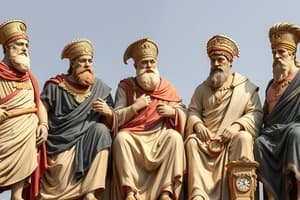Podcast
Questions and Answers
What event marked the beginning of the Third Century Crisis in the Roman Empire?
What event marked the beginning of the Third Century Crisis in the Roman Empire?
- The economic collapse
- The assassination of Emperor Severus Alexander (correct)
- The invasion of barbarian tribes
- The Plague of Cyprian in 251
How were emperors chosen during the Third Century Crisis?
How were emperors chosen during the Third Century Crisis?
- By appointment from the Senate
- Through a democratic election system
- By birthright succession
- Based on their popularity with the troops and generosity toward the military (correct)
What did Aurelian achieve during his reign that briefly alleviated the chaos of the Third Century Crisis?
What did Aurelian achieve during his reign that briefly alleviated the chaos of the Third Century Crisis?
- Defeating the breakaway Palmyrene Empire in the east and Roman usurper Tetricus in the west (correct)
- Forming an alliance with barbarian invaders
- Implementing a new currency system
- Establishing trade relations with Germanic tribes
What aspect of Roman governance changed during the Third Century Crisis?
What aspect of Roman governance changed during the Third Century Crisis?
What factor contributed to making it unsafe for merchants to travel during the Third Century Crisis?
What factor contributed to making it unsafe for merchants to travel during the Third Century Crisis?
Which of the following was NOT a pressure faced by the Roman Empire during the Third Century Crisis?
Which of the following was NOT a pressure faced by the Roman Empire during the Third Century Crisis?
Why did Diocletian implement the Tetrarchy system in 284–305 CE?
Why did Diocletian implement the Tetrarchy system in 284–305 CE?
What was the main responsibility of the Augusti in the Tetrarchy system?
What was the main responsibility of the Augusti in the Tetrarchy system?
Why did the Tetrarchy system eventually break down into civil wars after Diocletian's abdication?
Why did the Tetrarchy system eventually break down into civil wars after Diocletian's abdication?
Which factor led Diocletian to divide the Roman Empire into smaller administrative units?
Which factor led Diocletian to divide the Roman Empire into smaller administrative units?
Who was responsible for designating successors in waiting in the Tetrarchy system?
Who was responsible for designating successors in waiting in the Tetrarchy system?
Flashcards
Third Century Crisis Cause
Third Century Crisis Cause
The assassination of Emperor Severus Alexander in 235 CE started the political instability, economic decline, military defeats, and external invasions of the Third Century Crisis period.
Emperor Selection Method
Emperor Selection Method
Military acclaim, rather than succession, was used to choose new emperors, leading to frequent leadership changes.
Aurelian's Actions
Aurelian's Actions
Aurelian reunited the Roman Empire after it had broken up, regaining lost territories, and improving Roman prestige.
Governance Shift
Governance Shift
Signup and view all the flashcards
Merchant Discouragement
Merchant Discouragement
Signup and view all the flashcards
Empire's Pressures
Empire's Pressures
Signup and view all the flashcards
Diocletian's Tetrarchy
Diocletian's Tetrarchy
Signup and view all the flashcards
Augusti's Role
Augusti's Role
Signup and view all the flashcards
Tetrarchy's Failure
Tetrarchy's Failure
Signup and view all the flashcards
Administrative Unit Division
Administrative Unit Division
Signup and view all the flashcards
Tetrarchy Succession
Tetrarchy Succession
Signup and view all the flashcards
Study Notes
Third Century Crisis Overview
- The Third Century Crisis was initiated by the assassination of Emperor Severus Alexander in 235 CE.
- This period was characterized by political instability, economic decline, military defeats, and external invasions.
Emperor Selection
- Emperors were often chosen through military acclaim rather than a clear succession plan, leading to frequent changes in leadership.
- The rise of military generals as emperors showcased the fractured power structure during this era.
Aurelian's Achievements
- Emperor Aurelian reigned from 270 to 275 CE, successfully reunifying the empire after it had split into several competing regions.
- He initiated military campaigns that regained lost territories, restored Roman prestige, and reestablished control over the empire.
Governance Changes
- The Third Century Crisis saw a shift from the traditional senatorial governance model toward a more autocratic rule by military leaders.
- This transition marked a significant change in how power was concentrated and exercised.
Merchant Safety
- Increased invasions by barbarian tribes made travel perilous, discouraging merchant activities and disrupting trade routes.
- Economic instability and local conflicts created an environment unsafe for commerce.
Pressures on the Empire
- Pressures faced included military invasions, economic collapse, plagues, and internal political chaos.
- However, peace with external nations (like Sassanian Persia) was not a pressure, as conflicts were rampant.
Diocletian and Tetrarchy
- Diocletian implemented the Tetrarchy system (284–305 CE) to restore order by dividing the empire into four regions, each governed by an emperor.
- The Tetrarchy aimed to improve administrative efficiency and address the empire's vast challenges.
Responsibilities of the Augusti
- The Augusti (senior emperors) were primarily responsible for overseeing military matters and maintaining internal order in their respective regions.
Tetrarchy Breakdown
- After Diocletian's abdication in 305 CE, rivalries and power struggles among successors led to a resurgence of civil wars, undermining the Tetrarchy's stability.
Division of Administrative Units
- Dividing the empire into smaller administrative units helped manage vast territories more effectively, reflecting the need for localized governance.
- This restructuring was essential due to the empire's size and challenges.
Successor Designation
- In the Tetrarchy, senior emperors (Augusti) had the duty of appointing their junior counterparts (Caesars), creating a system for succession.
Studying That Suits You
Use AI to generate personalized quizzes and flashcards to suit your learning preferences.




